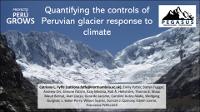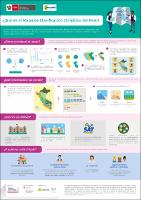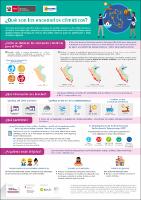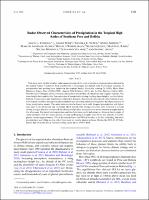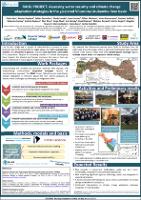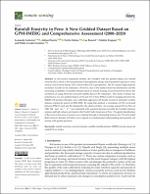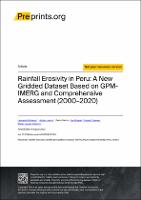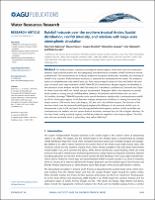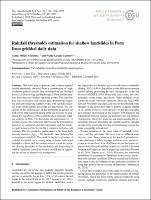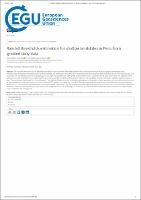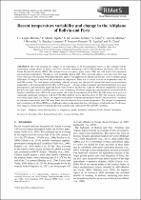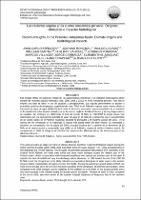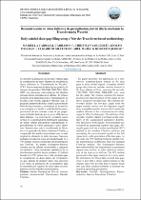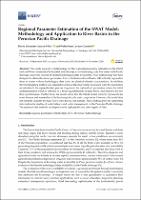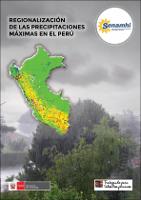Listar por título
-
Quantifying the controls of Peruvian glacier response to climate
Fyffe, Catriona L.; Potter, Emily; Fugger, S.; Orr, Andrew; Fatichi, Simone; Medina, Katy; Hellström, Robert Å.; Shaw, Thomas E.; Bernat, Maud; Llacza Rodríguez, Alan; Jácome Vergaray, Gerardo; Aubry-Wake, Caroline; Gurgiser, Wolfgang; Perry, L. Baker; Suarez, Wilson; Quincey, Duncan J.; Loarte, Edwin; Pellicciotti, Francesca
(American Geophysical Union, 2021-04)Acceso abiertoPeruvian glaciers are important contributors to dry season runoff for agriculture and hydropower, but they are at risk of disappearing due to climate warming. Their energy balance and ablation characteristics have previously ... -
¿Qué es el fenómeno El Niño en el Perú? en aprende con el SENAMHI
Servicio Nacional de Meteorología e Hidrología del Perú
(Servicio Nacional de Meteorología e Hidrología del Perú, 2017-09-26)Acceso abiertoEl Servicio Nacional de Meteorología e Hidrología del Perú -SENAMHI, brinda servicios de información de estudios, investigación científicas y asesoría en beneficios de nuestro país. En ese sentido, el presente video explica ... -
¿Qué es el friaje? en aprende con el SENAMHI
Servicio Nacional de Meteorología e Hidrología del Perú
(Servicio Nacional de Meteorología e Hidrología del Perú, 2021-02-12)Acceso abiertoEl material multimedia explica el evento meteorológico del friaje, frecuencia, características y efectos de esta masa de aire frío que viene del sur de continente, e ingresa por la Selva Sur desde de Madre de Dios, y llega ... -
¿Qué es el mapa de clasificación climática del Perú?
Servicio Nacional de Meteorología e Hidrología del Perú
(Servicio Nacional de Meteorología e Hidrología del Perú, 2020-12)Acceso abiertoExplica el proceso de actualización del mapa de clasificación climática del Perú, así como su utilidad e importancia en el marco de la gestión integral del Cambio Climático en nuestro país. -
¿Qué son los escenarios climáticos?
Servicio Nacional de Meteorología e Hidrología del Perú
(Servicio Nacional de Meteorología e Hidrología del Perú, 2020)Acceso abiertoEl presente material explica la importancia de generar Escenarios Climáticos en nuestro país para conocer las implicancias del Cambio Climático a futuro, para poder plantear medidas o políticas de acción en los tres niveles ... -
Radar-Observed Characteristics of Precipitation in the Tropical High Andes of Southern Peru and Bolivia
Endries, J. L.; Perry, L. B.; Yuter, S. E.; Seimon, Anton; Andrade, Marcos; Winkelmann, Ronald; Quispe, Nelson; Rado, Maxwell; Montoya, Nilton; Velarde, Fernando; Arias, S.
(American Meteorological Society, 2018-07-06)This study used the first detailed radar measurements of the vertical structure of precipitation obtained in the central Andes of southern Peru and Bolivia to investigate the diurnal cycle and vertical structure of ... -
RAHU Project: Assessing water security and climate change adaptation strategies in the glaciated Vilcanota-Urubamba river basin
Rau, Pedro; Buytaert, W.; Drenkhan, Fabian; Lavado-Casimiro, W.; Jimenez, Juan C.; Montoya, Nilton; Bonnesoeur, Vivien; Valdivia, Gustavo; Cachay, Walescka; Goyburo, Andres; Risco Sence, Eber; Abad, Jorge; Mackay, Jon; Hannah, David; Barrand, Nicholas; Siegert, Martin; Macera, Briggitte; Bueno, Marcelo; Baca, Carlos; Gianella, Cecilia
(European Geosciences Union, 2020)Acceso abiertoThe Peruvian Andes are a hotspot of vulnerabilities to impacts in water resources due to the propensity for water stress, the highly unpredictable weather, the sensitivity of glaciers, and the socio-economic vulnerability ... -
Rainfall along the coast of Peru during strong El Niño events
Sanabria Quispe, Janeet; Bourrel, L.; Dewitte, Boris; Frappart, F.; Rau, P.; Solis, Olimpio
(Royal Meteorological Society, 2017-09-26)Acceso abiertoWhile, climatologically, most areas of the Peruvian Pacific region do not experience precipitation, they can be affected by heavy rain and flooding during strong El Niño events with severe socio-economic impacts. Only four ... -
Rainfall Erosivity in Peru: A New Gridded Dataset Based on GPM-IMERG and Comprehensive Assessment (2000–2020)
Gutierrez, Leonardo; Huerta, Adrian; Sabino, Evelin; Bourrel, Luc; Frappart, Frédéric; Lavado-Casimiro, W.
(Servicio Nacional de Meteorología e Hidrología del Perú, 2023)Acceso abiertoIn soil erosion estimation models, the variables with the greatest impact are rainfall erosivity (𝑅𝐸), which is the measurement of precipitation energy and its potential capacity to cause erosion, and erosivity density ... -
Rainfall Erosivity in Peru: A New Gridded Dataset Based on GPMIMERG and Comprehensive Assessment (2000–2020)
Gutierrez, Leonardo; Huerta, Adrian; Sabino, Evelin; Bourrel, Luc; Frappart, Frederic; Lavado-Casimiro, W.
(Servicio Nacional de Meteorología e Hidrología del Perú, 2023)Acceso abiertoIn soil erosion estimation models, the variable with the greatest impact is rainfall erosivity (RE), which is the measurement of precipitation energy and its potential capacity to cause erosion, and erosivity density (ED), ... -
Rainfall hotspots over the southern tropical Andes: Spatial distribution, rainfall intensity, and relations with large-scale atmospheric circulation
Espinoza, J.C.; Chavez, Steven; Ronchail, Josyane; Junquas, Clémentine; Takahashi, Ken; Lavado-Casimiro, W.
(American Geophysical Union, 2015-05-11)Acceso abiertoThe Andes/Amazon transition is among the rainiest regions of the world and the interactionsbetween large-scale circulation and the topography that determine its complex rainfall distribution remainpoorly known. This work ... -
Rainfall thresholds estimation for shallow landslides in Peru from gridded daily data
Millán-Arancibia, Carlos; Lavado-Casimiro, Waldo
(European Geosciences Union, 2023-03-22)Acceso abiertoThis work aims to generate and evaluate regional rainfall thresholds obtained from a combination of high-resolution gridded rainfall data, developed by the National Service of Meteorology and Hydrology of Peru, and information ... -
Rainfall thresholds estimation for shallow landslides in Peru from gridded daily data
Millán Arancibia, Carlos; Lavado-Casimiro, W.
(American Geophysical Union, 2022-07-20)Acceso abiertoThe objective of this work was to generate and evaluate regional rainfall thresholds obtained from a combination of high-resolution gridded precipitation data (PISCOpd_Op), developed by the National Service of Meteorology ... -
Recent changes in monthly surface air temperature over Peru, 1964–2014
Vicente-Serrano, S.M.; López-Moreno, J.I.; Correa, Kris; Avalos, Grinia; Bazo, Juan; Azorín-Molina, C.; Domínguez-Castro, F.; Kenawy, A.E.
(John Wiley and Sons Ltd, 2018-01)This study assessed changes in the maximum and minimum surface air temperatures across Peru during the period 1964–2014. For this purpose, we employed the most complete records of air temperature series that were also ... -
Recent temperature variability and change in the Altiplano of Bolivia and Peru
López-Moreno, J.I.; Morán-Tejeda, E.; Vicente-Serrano, S.M.; Bazo, Juan; Azorín-Molina, C.; Revuelto, J.; Sanchez‐Lorenzo, Arturo; Aguilar, E.; Chura, O.
(John Wiley and Sons Ltd, 2015-08-26)Acceso abiertoThis work analysed the changes in air temperature in 25 meteorological stations in the Altiplano and the surrounding Andean slopes of Bolivia and Peru, and their relationship with El Niño-Southern Oscillation (SO) and the ... -
Las recientes sequías en la cuenca amazónica peruana: Orígenes climáticos e impactos hidrológicos
Espinoza, J.C.; Ronchail, Josyane; Lavado-Casimiro, W.; Santini, W.; Vauchel, P.; Pombosa, Rodrigo; Villacís, Marcos; Carranza, Jorge; Junquas, Clémentine; Drapeau, Guillaume
(Servicio Nacional de Meteorología e Hidrología del Perú, 2011)Acceso abiertoEste trabajo ofrece un panorama inicial de las características climáticas y los impactos hidrológicos afines durante las recientes sequías extremas (1995, 1998, 2005 y 2010) en el río Amazonas peruano. Para ello se empleó ... -
Reconstrucción de datos faltantes de precipitación pluvial diaria mediante la Transformada Wavelet
Carbajal Carrasco, Mariella; Yarlequé, Christian; Posadas, Adolfo; Silvestre, Elizabeth; Mejía, Abel; Quiroz, Roberto
(Servicio Nacional de Meteorología e Hidrología del Perú, 2011)Acceso abiertoSe describe la aplicación de un nuevo método para la completación de datos faltantes de precipitación diaria utilizando la “Transformada de Wavelets” (TW). Series completas de datos de precipitación diaria para los períodos ... -
Regional maximum rainfall analysis using L-moments at the Titicaca Lake drainage, Peru
Fernández Palomino, Carlos; Lavado-Casimiro, W.
(Springer-Verlag Wien, 2017-08)Acceso cerradoThe present study investigates the application of the index flood L-moments-based regional frequency analysis procedure (RFA-LM) to the annual maximum 24-h rainfall (AM) of 33 rainfall gauge stations (RGs) to estimate ... -
Regional parameter estimation of the SWAT model: methodology and application to river basins in the Peruvian Pacific drainage
Asurza Véliz, Flavio Alexander; Lavado-Casimiro, W.
(MDPI AG, 2020-11-16)Acceso abiertoThis study presents a methodology for the regional parameters estimation of the SWAT (Soil and Water Assessment Tool) model, with the objective of estimating daily flow series in the Pacific drainage under the context of ... -
Regionalización de las precipitaciones máximas en el Perú
Tupac Yupanqui Vélez, Raúl Antonio; Lavado-Casimiro, W.; Felipe-Obando, Oscar
(Servicio Nacional de Meteorología e Hidrología del Perú, 2017-12)En el presente estudio se aplica el análisis regional de frecuencias (ARF) para precipitaciones máximas (anual en 24 horas) de estaciones pluviométricas administradas por el SENAMHI a nivel nacional. Para tal fin se utilizó ...







